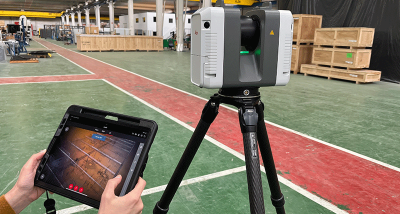During the SPAR 3D / AEC Next 2019 events, Geomni presented during the product preview session to highlight the advantages of their agile infrastructure that can measurably help professional Photogrammetry, Surveying, and Mapping firms and departments (PSM’s). Numerous companies showcased their innovative and new products during this session, which included everything from software upgrades to an exploration of how terrestrial data can be leveraged at every stage of the BIM process. However, Geomni’s commitment to create the most efficient and largest private fleet of survey aircraft and to make the data licensable and accessible to users stood out as a unique approach.
Geomni is part of the Verisk Analytics Enterprise, providing geospatial information for insurance, banking, and financial clients. However, they are also able to work “with and through” mapping professionals to help PSMs get the data they need, while significantly reducing their costs. Geomni’s goal is to help find cost-effective, efficient means off collecting geospatial data and imagery so that their PSM clients can make more informed, data-driven decisions. By utilizing a large fleet of aircraft, drones and advanced equipment, Geomni has worked to reduce the time and the cost that would typically be required for data acquisition.
The Geomni fleet includes over 100 fixed-wing aircraft and platforms strategically located at fifteen hubs across the United States, allowing for deployment anywhere in the continental U.S. in a matter of hours. This fleet includes the latest cameras, sensors and lidar scanning equipment, all of which can be deployed rapidly following unpredictable events such as storms or other natural disasters. All of this data can be used to assess structures, provide information for insurance claims, or to create valuations of damage, with quicker turnaround and lower costs, a key goal according to Geomni CRO Todd Stennett.
“Having high-efficiency resources sprinkled across the nation, close to ‘Anywhere, USA’ makes a material difference, eliminating a lot of inefficient ferry time and cost.”
In addition to their aerial survey infrastructure, Geomni maintains a large, and frequently updated library of high-resolution imagery. Originally collected for insurance industry needs, the Geomni data library contains both lidar, photogrammetry and obliques (45-degree angled views) that can be used for urban planning, architecture, engineering, and commercial property assessments. For the sampled areas, the library includes high quality .jpg files, lidar las and laz files, obliques from the primary compass directions (e.g., N, S, E, W), and downward-looking NADAR shots. Unlike other libraries, the assets also come complete with the addition of high-quality metadata that can give users more flexibility and, ultimately, the ability to make high-precision 3D measurements. The metadata is what enables someone else to use the imagery in their own systems for tools, and make sense of locations, pixel sizes, and accuracies.
Geomni’s airborne data acquisition is aimed to capture areas with populations of over 50,000 people at least annually, and for towns with populations between 15-50 thousand residents, the data should be under 24 months old. In addition, thousands of “on-demand” data acquisition missions contribute to Geomni’s library.
“We want the AEC industry to be aware of the massive data repository being collected,” says Stennett, “The gates are now open to anyone who wants to directly use it… and put that data to work themselves.”
Data from this library can already be ordered via reports – for example Geomni Roof or Geomni Property for specified areas – that provided additional calculations as requested (e.g., materials cost, valuation, etc.). However, many firms have their own analysts or tools to process this data themselves and may need to make their own specialized measurements. By licensing access to Geomni’s database, they can access all of the data and use what they need. According to Stennett, this access could allow companies to, “do more, do it faster, and with fewer risks.”
Clients interested in access to the data repository can license access for as little as $99/month ($999/year), which includes access to unlimited data for measurements. Licensed users can have access to the entire catalog of high-resolution data, as well as tools to make, store, and export accurate measurements in common CAD formats. Interested users can get started on the Geomni website.
For larger, or more recurring needs, downloads and API calls can be set up. The exact pricing would depend on the age, resolution and difficulty of acquiring a particular area – so firms and companies requiring a more automated or large-scale delivery of data are encouraged to contact Geomni to discuss pricing.









